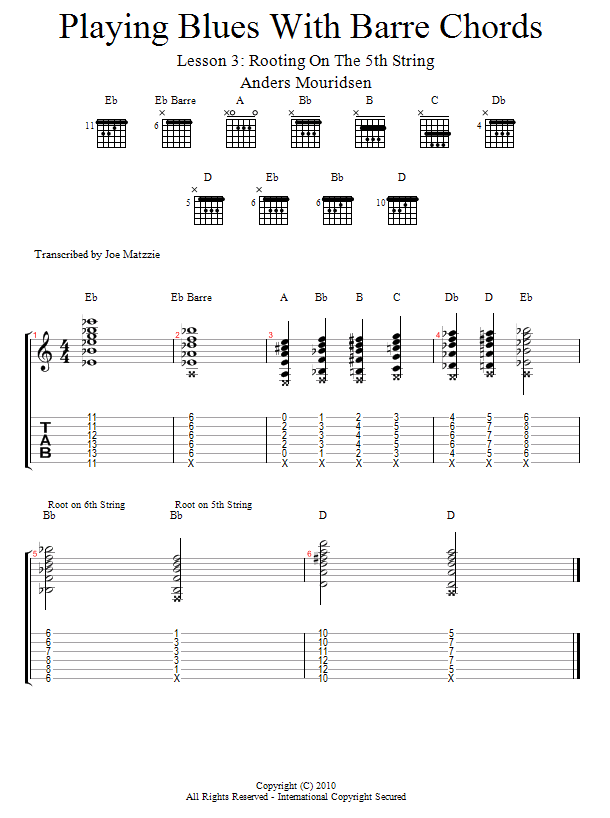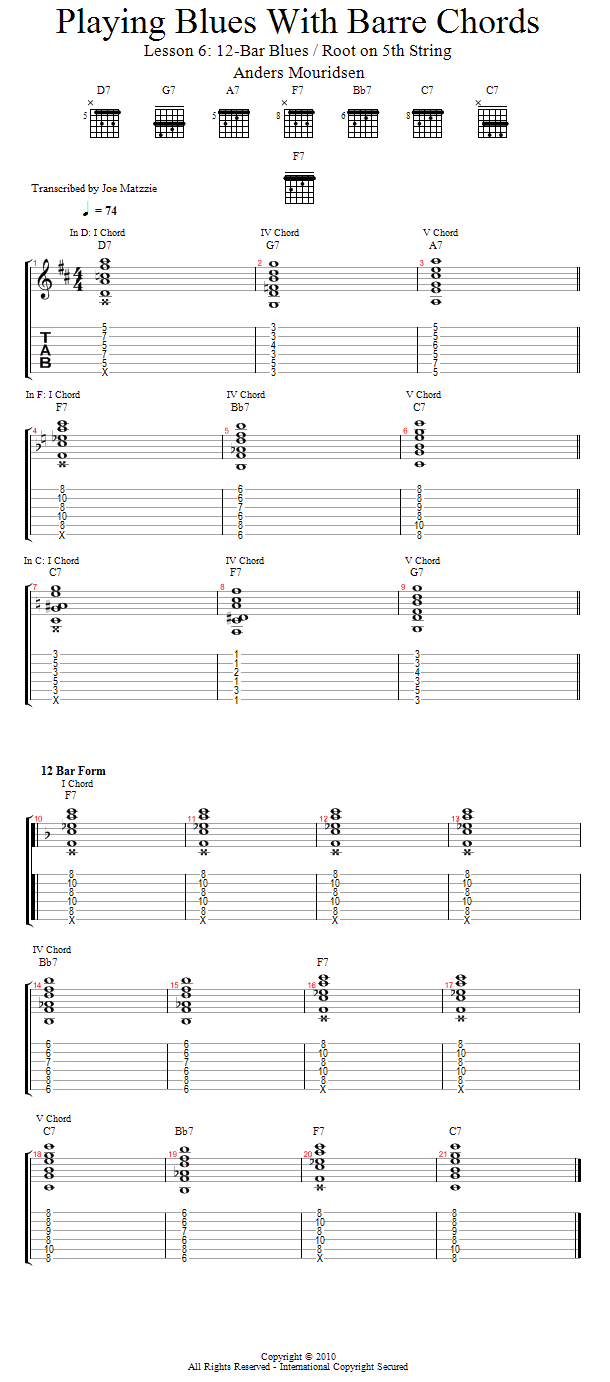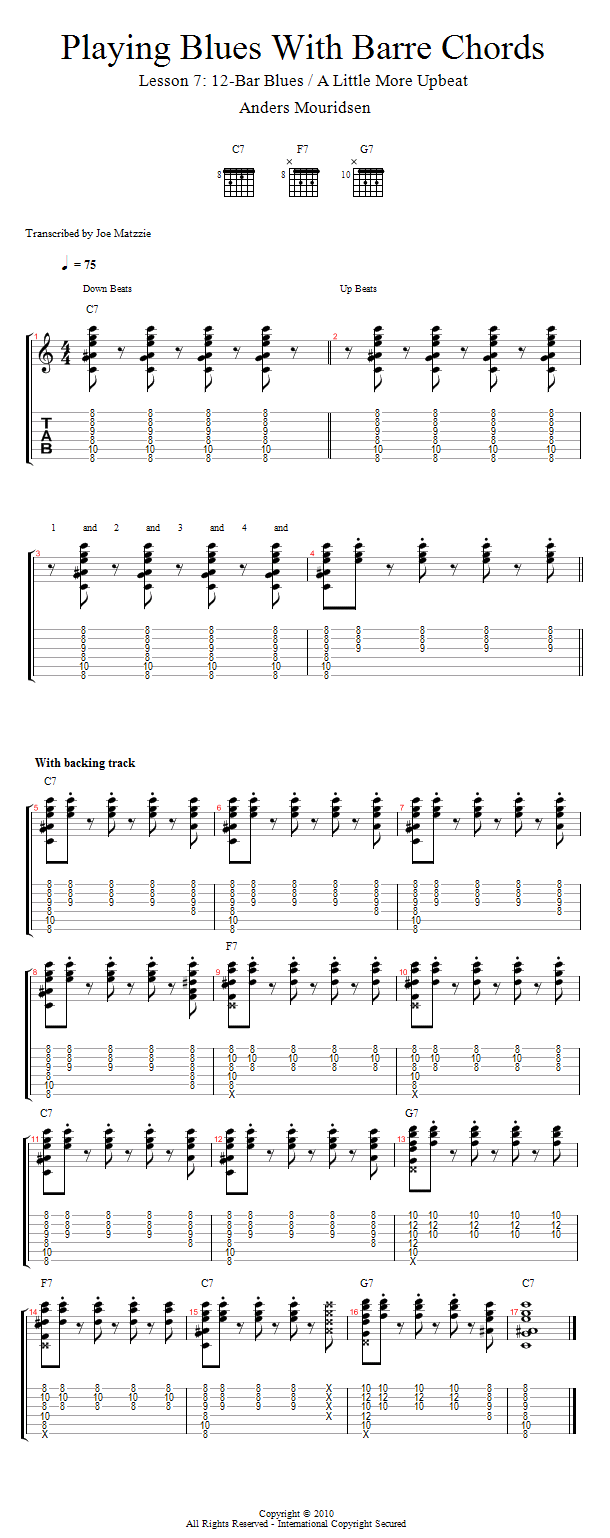Scottoro
Chapter 2: Blues With Power and Barre Chords
In this chapter you will expand your knowledge and skills by playing the 12 bar blues form using power chords. You’ll also add crucial basic strumming, muting and techniques.
Tutorial: Power Chords in the Blues
In this tutorial we will through the basics of voicing, left hand muting, strumming and palm muting power chords. Getting comfortable with this will ultimately enable you to play the 12 bar form in any key as well as adapt your rhythm playing to different blues grooves!
Intro to Power Chords In Blues
In this chapter you’ll learn to play blues with power chords and barre chords. Learning this will ultimately enable you to play the blues in any key and over many different types of blues grooves.
In this first tutorial we’ll be working on the power chord, and once we’ve gone through the basics we’ll look at how it’s used in the context of the blues.
Get Started: Power Chords in Blues

The power chord is a really useful concept whether you want to play blues or almost any other style of music. In this tutorial we are looking at how it is used in a blues context, and in this first lesson I’ll show you how to play a basic power chord!
Moving Power Chords Around

In this lesson we’re going to move the power chords around the neck to fit different keys. This includes moving the voicing to the 5th, 4th and 3rd string. You will need these basic skills to use power chords in the blues!
Strumming Blues Power Chords

Now that we have covered what to do in your left hand, it’s time to look at what to do in your right hand, when you want to use power chords in blues!
Palm Muting Blues Power Chords

In this lesson we’re going to look at another useful right hand technique called “palm muting”. This technique is used in all styles of music and works extremely well for power chords in blues.
Conclusion: Power Chords In Blues

In this tutorial we have covered most of the basic technique that you need to be able to use power chords in blues. In the next tutorial we are gonna make some music with it!
Tutorial: More Blues with Power Chords
In this tutorial we will be using the power chords that you learned earlier to play some blues. We are gonna talk about how to find the power chords for the 12 bar form in any key and try it out the “the band”. We are also gonna cover a really useful blues “riff” played with power chords that you often hear in slow blues tunes.
Intro to More Blues With Power Chords
In this tutorial we’ll be using the power chords that you learned earlier to play some blues. We’re going to talk about how to find your I, IV, and V chord in any key, and we’ll also talk about what types of blues grooves the power chords work well for!
Finding The 12 Bar Anywhere!

In this lesson we’ll look at power chords with the root on the low E string and how to find your IV and V chords from there. This will enable you to play the 12 bar blues in any key, as long as you can find the I chord on the 6th string. Good stuff!
One Chord, Root On The 5th String

When you move up the neck the frets get smaller and smaller. Therefore it’s most comfortable for most players to stay somewhere between the 1st and the 10th fret when playing power chords. But in order to do so, you need to be able to find your I, IV, and V chord when your I chord has the root on the 5th string. Don’t be confused, just watch this lesson and play along with me at the end!
Power Chords As Riffs

In this lesson we’ll add a really cool blues riff to the I chord. The riff is played with power chords and is a great exercise in moving them around. Depending on how hard it is for you to do, you can leave out the riff in certain parts of the 12 bar form. For example, right before a chord change.
Conclusion: More Blues with Power Chords
Power chords are used in many different styles of music and in many different ways. In these lessons we’ve looked at an example of how they are used in the context of the blues, which is most often over the slower and really sparse blues grooves like you heard in the backing track. Have fun with the power chords!
Tutorial: Playing Blues With Barre Chords
In this tutorial I will show you how to play basic barre chords and how to use them in a blues context. The basic barre chord shapes can be very hard to play at first, but if you fight through the pain, I will show you how to use them in a blues context. These are really useful guitar skills that you are going to use for years and years to come, in blues and in all other styles of music, so don’t give up on it just because it seems difficult at first!
Introduction: Blues With Barre Chords
In this tutorial I’m gonna teach you how to play blues with barre chords. It’s a hard but really useful skill, that ultimately will enable you to play the blues in any given key with full chords. And barre chords are used in all styles of music, so you’re improving much more than just your blues playing by working on this.
The Major Barre Chord

In this lesson I’ll show you how to play a basic major barre chord. This is not something you’ll get good at just by watching this video. It will take some time and hard work, and it may seem impossible at times. But we’ve all been there, and we all learned it eventually so you can too!
Major Barre Chords: Root On The 5th String

It’s always easiest to play barre chords somewhere between the 12th and the 4th fret. Up high, the frets are so small that it can be hard to fret and down low the strings are physically harder to press down. So in order for us to be able to stay where it’s comfortable, we’ll need a major barre chord that has the root on the 5th string. Check it out!
Dominant 7 Barre Chords in Any Key

In this lesson I’ll show you how to play a dominant 7 chord as a barre chord. You’ll need a voicing with the root on the 5th string and one with the root on the 6th string. This can be pretty tricky, and if you don’t do it right, it ends up sounding like a regular major chord. So make sure to arpeggiate your chords and make sure you can hear the bluesy tension from the dominant 7 note!
Playing the 12 Bar Form with Barre Chords

In this lesson we’re gonna use the dominant 7 barre chords to play through the 12 bar form. Make sure you’re at least somewhat comfortable with the barre chords, before you try to do this!
The I Chord, Root On The 5th String

In this lesson we’re also gonna play through the 12 bar form with dominant 7 barre chords, but now in a key, where you have to voice the I-chord as a barre chord with the root on the 5th string! This means that finding your IV- and V-chord will be a bit different.
A Little More Upbeat!

So far we’ve been playing the barre chords as whole notes, so in this lesson I’m gonna show you a very simple and useful strumming pattern that works great with barre chords!
Conclusion: Blues with Barre Chords
In this tutorial I’ve shown you all the basic technique and knowledge you need to be able to play blues with barre chords. Now it’s up to you to put some time in to it! Barre chords is a beast for most people, but the trick is to just keep using them, even if they don’t sound that great. Because eventually they will!